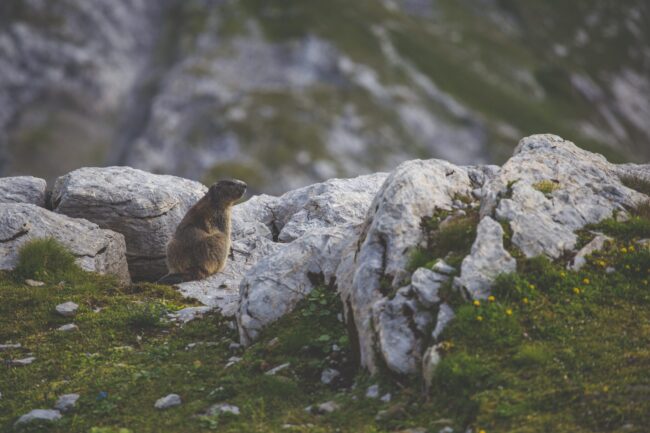Table of Contents
Groundhogs, also called woodchucks, are rodents. Interestingly, they are one of 14 species of ground squirrel. They also have the honor of being the largest member of the squirrel family, weighing up to 13 pounds.
Where Do They Live?
These woodchucks can only be found in North America; all the way from Canada to the Southern parts of the United States. Closer to home, groundhogs are commonly found near the edge of a forest (although some prefer waddling around in dense forests), pasture areas, grasslands, and rivers.
They Look Helpless, Are They?
Fun Fact: Groundhogs look lumpy but they can swim and climb trees.
These rodents also dig burrows, both as a means to protect themselves and to provide a cozy place that will help them get through the winter. Groundhogs are neat creatures and regularly clean their burrows by changing the nesting material.
What Do Groundhogs Eat?
Groundhogs are vegetarians. They usually eat fruits, plants, bark, and grass. They are also known to damage crops and gardens, and many consider them pests.
Do Groundhogs Actually Hibernate?
Yes, groundhogs hibernate. In fact, because they sleep all winter groundhogs are “true hibernators.” Once they settle down for the winter, their body temperature and heart rate are drastically reduced.
A groundhog’s temperature can fall below 20 degrees Celsius (68 degrees Fahrenheit) but during their winter’s sleep, groundhogs usually drop their body temperature from 99F to 37F, according to the National Wildlife Federation. Their heartbeat also ranges from 80 beats to 5 beats per minute.
How Long Do Groundhogs Hibernate?
Most groundhogs snooze from late autumn or early winter to early spring. However, their winter sleep depends on their location. Groundhogs living in the northern areas hibernate longer than the ones living in the southern areas.
Hibernation is not a deep sleep that lasts all winter. Instead, these rodents experience dormancy when their body temperature drops to about 25 degrees Fahrenheit (5 degrees C). They will do this for about a week, then wake up for three or four days, and then return to dormancy. They continue this cycle 12 to 20 times during winter.
Why Do Groundhogs Hibernate?
Groundhogs are mostly herbivores, although they occasionally eat insects and other arthropods. Due to this plant-based diet, it is difficult for these woodchucks to get the food they need to survive the long winter.
To survive, they must consume as few calories as they possibly can on a daily basis. However, in the period leading up to hibernation, groundhogs must stuff themselves. A poor diet before hibernation could cause starvation during winter – and even death during hibernation.
How Do Groundhogs Prepare For Hibernation?
Groundhogs spend a good amount of time during the warmer months preparing for their winter sleep. Females give birth in early spring, usually early April or late March. This gives the kids time to mature during the summer so they can dig their burrows in winter.
To survive the winter, groundhogs start to gain weight and eat as much as they need in summer. They continue to forage until fall. Groundhogs aim to consume and store enough food, especially apples, walnuts, raisins, and other high-calorie protein foods that are high in fat. Alfalfa is another key groundhog food. In late summer, its leaves are abundant and provide nutritious and dense food for groundhogs.
During the summer months, a groundhog can fill up more than a pound of vegetation, much like a 150-pound man who scarfs down a 15-pound piece of food. To accommodate this physical appetite, these woodchucks are blessed with upper and lower incisors that can withstand wear and tear (these snappers grow about one-sixth of an inch each week).
Along with plants, they also eat grubs, grasshoppers, insects, snails, other small animals, and even bird eggs.
Hibernation Period
Groundhogs are usually active until winter frosts start in October or November. Then, they crawl into their nests and enter hibernation. In this fashion, they hide in till February or March until the weather begins to warm up.
While they can sleep for up to five months, some sleep only for two to three months, depending on the local temperature.
Male groundhogs are the first to come out from their hibernation period. They usually emerge from their nests in February and usually start to look for females. Once a male has located her nest, he’ll go back to sleep for another month and wake at the beginning of March to mate. Groundhogs usually mate in early spring.
A Quick Summary
Groundhogs, or woodchucks, are rodents native to North America. They hibernate from late fall or early winter until early spring. They are known as the true hibernators since their body temperature can go below 20 degrees Celsius and their heart rate can drop to five beats per minute.
Due to the lack of vegetation in winter, they eat as much as possible during warmer times and store calories and food for their hibernation period.
The males come out of their hibernation period to find their mates and then go back into hibernation for another month. March both marks the end of hibernation and the start of mating season.
Groundhog hibernation introduced into American culture the famous Groundhog Day. This day is celebrated on February 2 every year. According to lore, if a groundhog sees its own shadow on that day, there will be another six weeks of winter!



